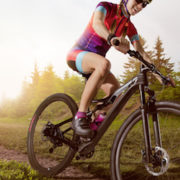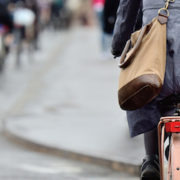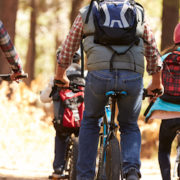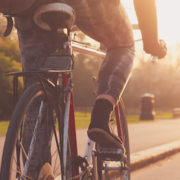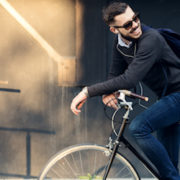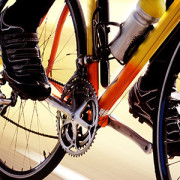How to Choose the Best Bike for You
Article by Beth Orwenstein | Found on Everyday Health
With the warm weather just around the corner, the urge to hop on a bike and go for a long ride can be pretty strong. “Riding a bike is fun because you can see the scenery go by,” says Alice Burron, MS, an exercise physiologist in Cheyenne, Wyo., spokeswoman for the American Council on Exercise, and author of Four Weeks to Fabulous. “You can do it with friends. You can do it alone. You can ride in the mountains. You can ride in the city. It’s very versatile and it’s a great exercise for a change of pace.”
Biking is great for calorie burn. You can burn roughly 200 calories an hour on a leisurely bike ride; 450 to 600 calories if you’re biking at a good clip. “The harder you pedal, the steeper the hills, the more calories you’ll burn,” Burron says. “I love biking because not only is it a great aerobic exercise, it’s very easy on the joints. It’s one of my favorite activities for people with knee injuries.”
But wait! Before you can go, you need to invest in a good bike. Here’s how.
Good bikes can be pricey — running anywhere from several hundred to several thousand dollars. You can get bikes at places like Wal-Mart for less than $200 or at garage sales for even less, but it’s oftentimes worth the extra money to shop at the local bike store where the owner and his employees can help you with your selection, Burron says. “If you defer to your local bike shop, the salespeople can help you find the right bike for your needs and make sure that the bike you want fits you, too,” she explains. Besides, cheap bikes have to be replaced more often, and if you maintain your good bike, you can keep it for years, saving money in the long run. (Some bike shops offer trade-ins that can be good deals.)
When choosing a bike, start by asking yourself these questions:
- Where do I want to ride it? (Mostly on roads or trails?)
- Why do I want to ride? (For fun? For fitness? To do errands and save gas?)
- What’s the most comfortable position to ride? (Fully upright? Leisurely and leaning forward? Or racing mode?)
Your answers to these questions can help you determine which type of bike you need, Burron says.
Your choices include:
- Mountain bikes. Mountain bikes are okay for pavements, but work best on dirt roads. “I think they’re really good if you want to climb some hills,” Burron says. “They don’t go too fast because their wheels are smaller.”
- Road bikes. These have narrower wheels than mountain bikes and are good if you ride mostly on roads. “They’re great for touring and going long distances on streets,” Burron says. “Proper fit is most important with this one, especially if you’re going to be riding it long distances.”
- Hybrids. A hybrid is a cross between a mountain bike and road bike. “They’re good for pavement and can go off road, too,” Burron notes. “Generally, they’re mid-weight and they’re fun. They come in all kinds of colors now and a variety of prices. For the most part, a hybrid is a good starting bike for people who want to get into biking.”
- Recreational bikes. “Recreational bikes put a smile on your face,” Burron says. “Stick a basket on them and go shopping. They’re not only great fun for leisurely rides but they also get you from point A to point B, and you can even stop for coffee along the way. They’re coming out with some really nice recreational bikes now.”
- Racing bikes. Racing bikes are the lightest in weight and are designed for speed. To make them light, they are made out of high-tech materials and can be the priciest.
Many Web sites offer exercise bike reviews. You can check them out for the best bikes in the category you choose.
Finding the Proper Fit
A knowledgeable bike seller is your best bet for making sure you get the proper fit, whatever bike you choose. If the bike doesn’t fit you properly, “you can get a lot of muscle pain and it can discourage you from riding,” Burron warns. You’re also more prone to falling. Most bikes have some room for adjustment. “But you can only adjust it to a point. You might want to go up or down a size,” Burron adds.
Some rules-of-thumb for sizing your bike:
- Make sure your leg is at a slight bend when the pedal is at its lowest point in the rotation. “You can vary that by adjusting the seat,” Burron says.
- Your arms should have a slight bend in the elbow, so you’re not too far or too close to the handlebars.
- When you stand straddling the bike, you want 1 inch of clearance between your crotch and the bar (if it’s a man’s bike), maybe 2 inches if you’re looking at a mountain bike. If it’s a woman’s bike and has no bar, this advice doesn’t apply, Burron notes.
How to Outfit Your Bike
- Helmets. Get a good helmet. This is not an option. A helmet is critical for protecting yourself from serious head injuries. You should wear a helmet no matter whether you’re riding for fun or for exercise — and whether you’re 6 or 60 years old. “The helmet should fit properly just like your bike,” Burron says. “It should rest on your head about an inch above your eyebrows. It shouldn’t be too loose or too snug.” If you’re riding in the hot weather, you might want a helmet that has air holes for ventilation. “You can get caps that cover the holes in colder weather,” Burron adds. The lighter the helmet, the more expensive it tends to be, but a good helmet is a very worthwhile investment, she says.
- Hard or soft seats. Some people prefer hard seats, some prefer soft. “I have a boney butt so I like padded seats,” Burron says. “But I would suggest whatever you’re most comfortable with. It’s a matter of personal preference. There is no right or wrong.” You can even buy a seat and swap it with the one that comes with the bike.
- Gloves. “I would recommend padded bike gloves,” Burron says. “They make riding very nice and comfortable.” They also protect your hands in the event of a fall.
- Baskets or packs. If you plan to ride to the store to pick up a few items, a basket or bike pack can come in handy. Don’t use a backpack because you could hurt your back. A waist or fanny pack may be okay, but won’t give you a lot of room.
- Locks. If you’re planning on using your bike as a mode of transportation, you need a good lock so you can secure your bike when you reach your destination.
Grounded in the belief we are all unique beings, we begin each new client with a meticulous bio-mechanical evaluation, assessing each joint in its relationship to the movement of the body as a whole. Our therapists are skilled at reading the unique story your body tells, and treating everything from the bottom of your foot to the top of your head.
Bodywise Physical Therapy is located in Portland, Oregon. The Bodywise approach is wholistic, individualized, and can benefit people of all fitness levels. While Bodywise has always specialized in general orthopedics, spine rehabilitation, and sports medicine, they have evolved into a truly wholistic practice integrating Hands-on treatments with Mindfulness, Pilates, Trauma Release Exercise, Womens Health and Lymphedema.
